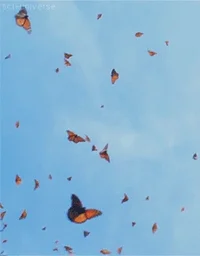Controversial weedkiller could spell big trouble for monarch
butterflies
 By 2019, a weed killing
chemical—designed to be used in tandem with genetically modified cotton and
soybean seeds—is projected to be sprayed on more than 60 million acres of
monarch butterfly U.S. migratory habitat, according to a report released today by the Center for
Biological Diversity.
By 2019, a weed killing
chemical—designed to be used in tandem with genetically modified cotton and
soybean seeds—is projected to be sprayed on more than 60 million acres of
monarch butterfly U.S. migratory habitat, according to a report released today by the Center for
Biological Diversity.
Citing this potential
devastation to monarch populations, which have already decreased an estimated
80 percent over the past two decades, the report calls on the U.S.
Environmental Protection Agency not to renew the registration of the weed
killer, called dicamba, when it expires at the end of this year.
The concern is the
chemical could cause more habitat loss and decreased milkweed, which is the
only food plant used by monarch caterpillars. Monarchs winter in Mexico and
some warm areas of Southern California and they return to areas throughout the
U.S. in the spring.
"America's monarchs
are already in serious trouble, and this will push them into absolute
crisis," said report author Nathan Donley, a senior scientist at the
Center, in a statement.
Donley and colleagues looked at monarch habitat in the U.S. and estimated how much dicamba will be sprayed. In addition to the estimated 60 million acres to be sprayed, an additional 9 million acres could be threatened by the chemical drifting.
The weed killer gained
notoriety this year as farmers planted more than 25 million acres with new
soybean and cotton seeds genetically modified to be resistant to dicamba.
Monsanto, BASF SE and DowDuPont all make dicamba-based herbicides.
In many areas the weed
killer drifted onto nearby fields and killed crops, spurring lawsuits in
Arkansas, Missouri, Kansas and Illinois. Arkansas banned dicamba; North Dakota,
Missouri and Minnesota put restrictions in place.
"In 2017 there were
reports of at least 3.6 million acres of off-target, herbicide-induced damage
to agricultural crops and an unknown amount of damage to native plants and
habitats, including forests," according to the Center's report.
Dicamba is a threat to
monarchs because it can destroy flowering plants that provide nectar for adult
butterflies as they travel south for the winter and by harming milkweed, which
is the "only food source of the monarch caterpillar" and
"provides an essential resource for reproduction," stated the report.
"When dicamba's use
on [genetically engineered] cotton and soybeans comes up for reapproval later
this year, the only responsible thing for the EPA to do is allow that approval
to expire," Donley said.
We've reached out to
Monsanto to comment on the report.
RELATED
ARTICLES AROUND THE WEB